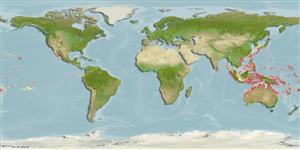Preferred temperature (Ref.
123201): 24.7 - 29.3, mean 28.5 °C (based on 2149 cells).
Phylogenetic diversity index (Ref.
82804): PD
50 = 0.5000 [Uniqueness, from 0.5 = low to 2.0 = high].
Bayesian length-weight: a=0.00562 (0.00258 - 0.01228), b=3.08 (2.89 - 3.27), in cm total length, based on LWR estimates for this (Sub)family-body shape (Ref.
93245).
Trophic level (Ref.
69278): 3.1 ±0.3 se; based on size and trophs of closest relatives
Widerstandsfähigkeit (Ref.
120179): hoch, Verdopplung der Population dauert weniger als 15 Monate. (Preliminary K or Fecundity.).
Fishing Vulnerability (Ref.
59153): Low vulnerability (10 of 100).
Nutrients (Ref.
124155): Calcium = 636 [181, 3,816] mg/100g; Iron = 3.46 [0.93, 9.61] mg/100g; Protein = 18.1 [15.9, 20.2] %; Omega3 = 0.098 [0.016, 0.665] g/100g; Selenium = 104 [12, 665] μg/100g; VitaminA = 23.6 [1.9, 282.4] μg/100g; Zinc = 7.75 [2.73, 17.14] mg/100g (wet weight);
